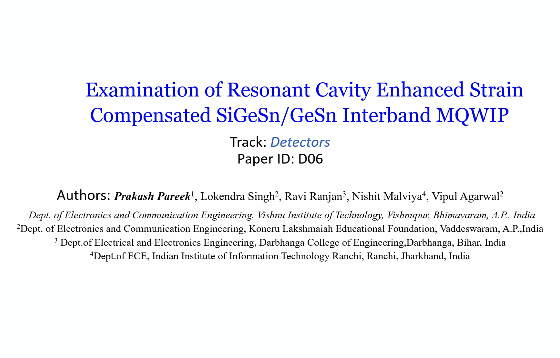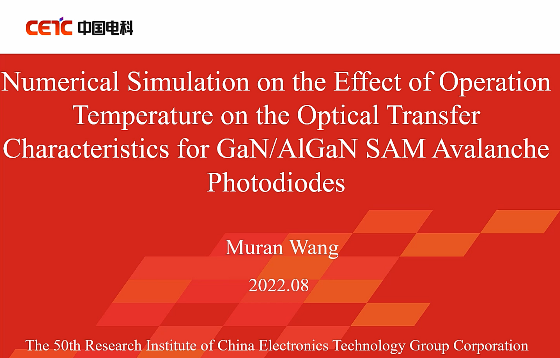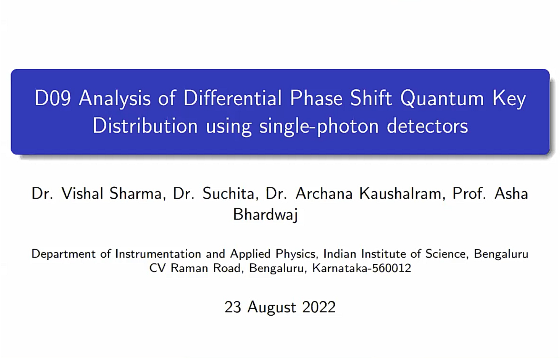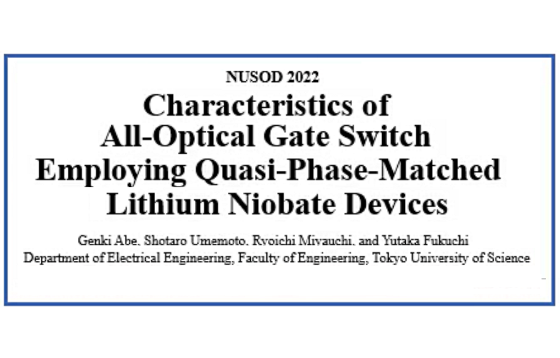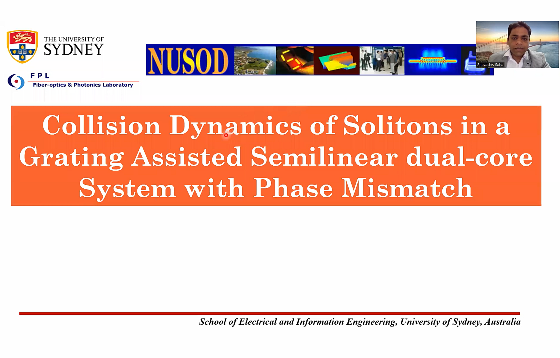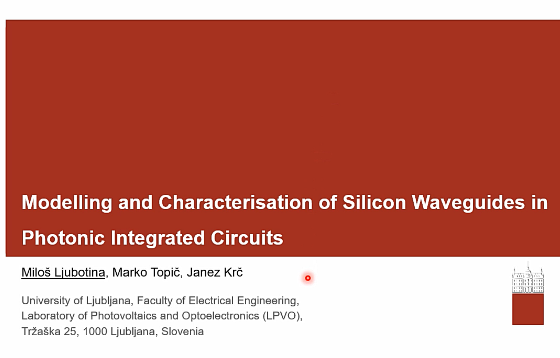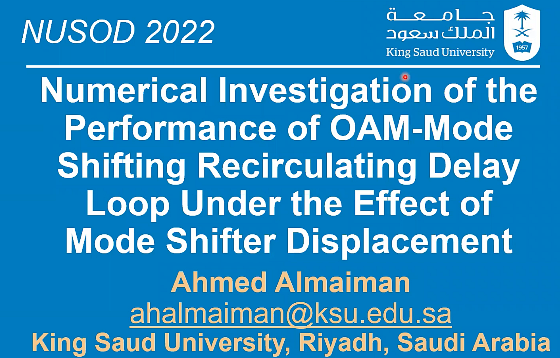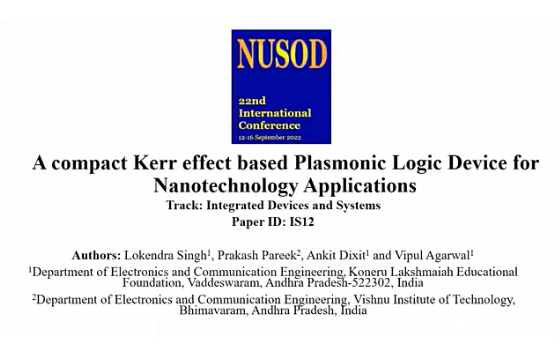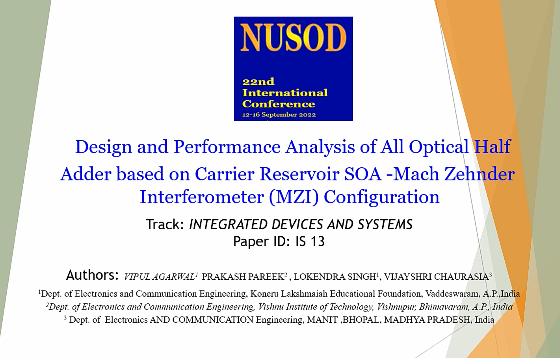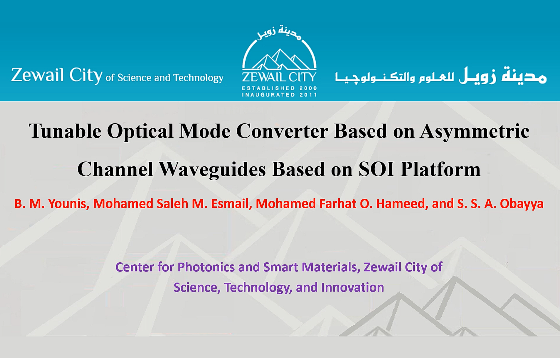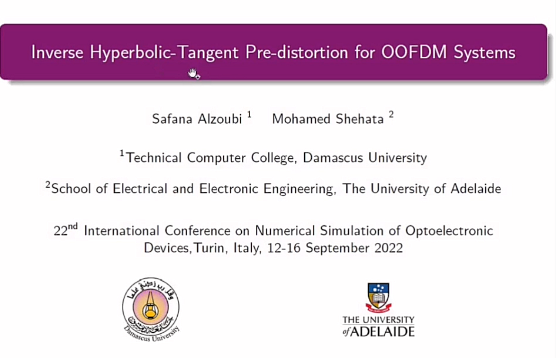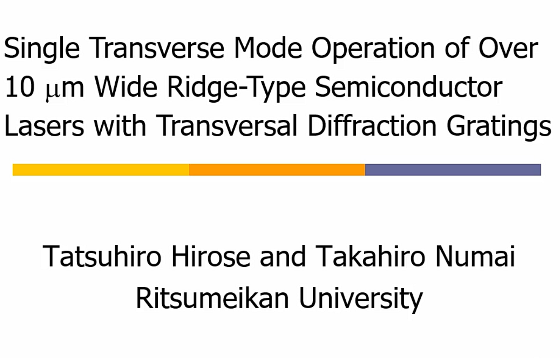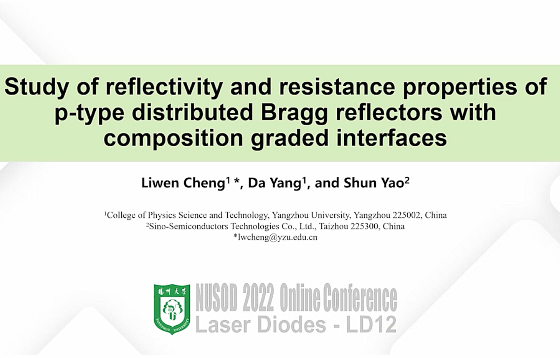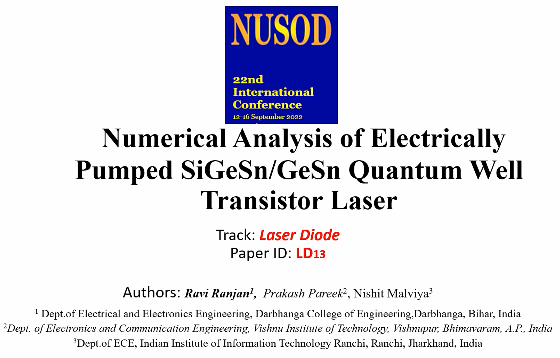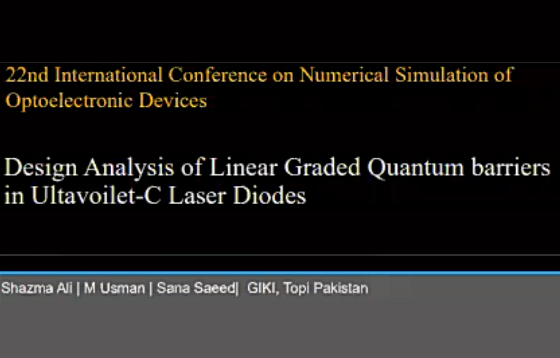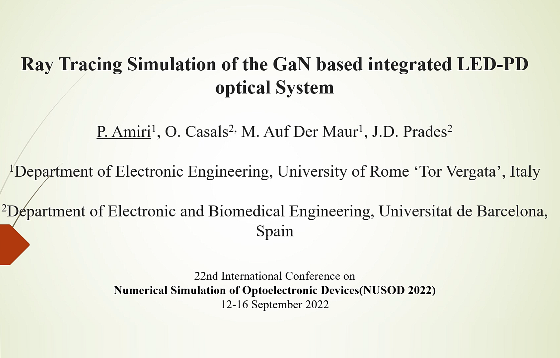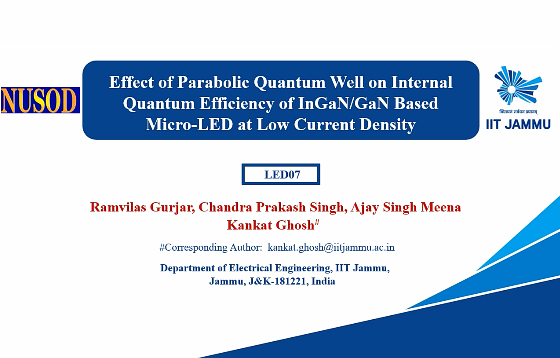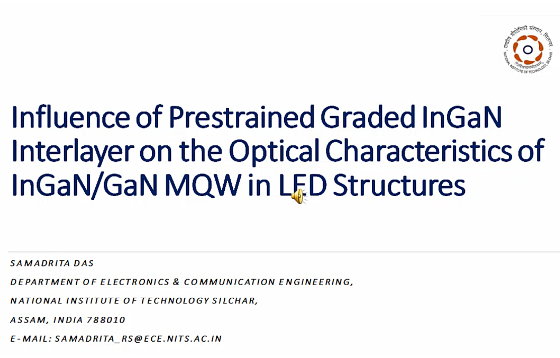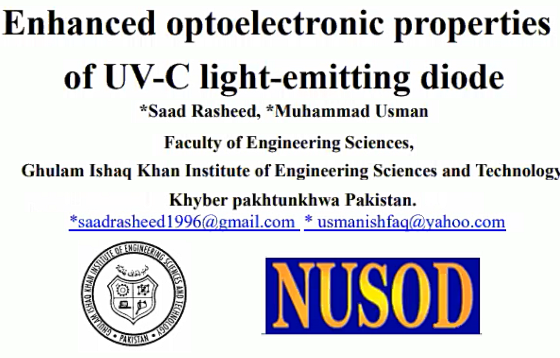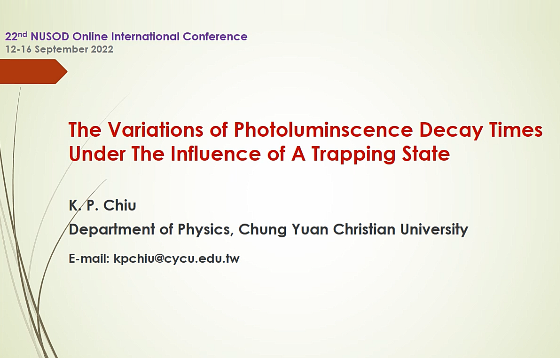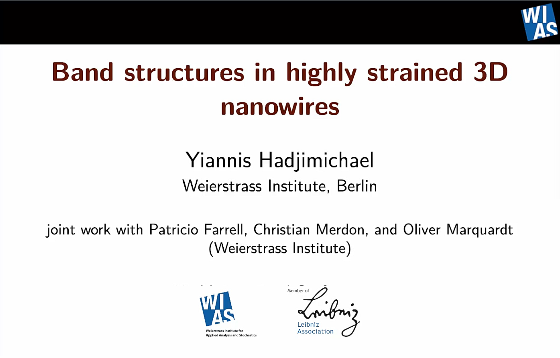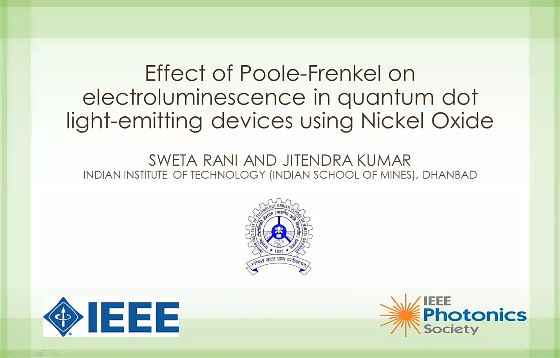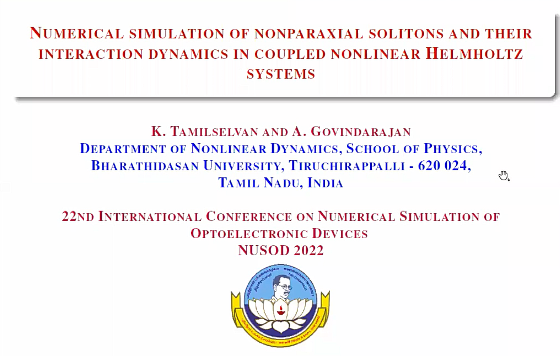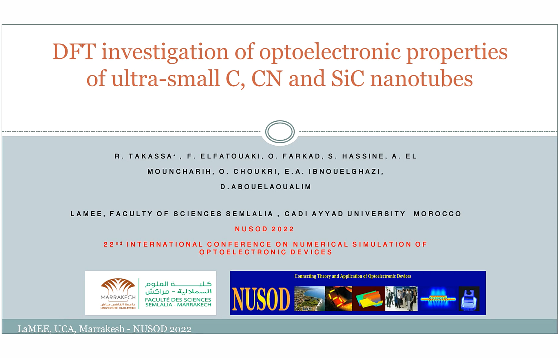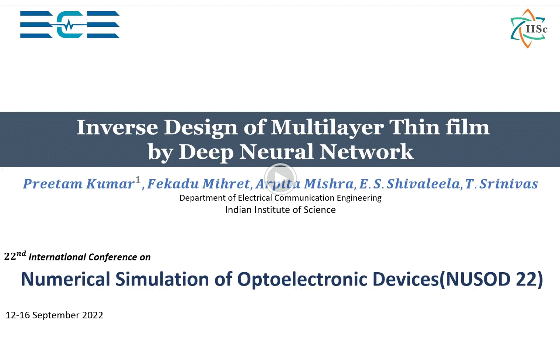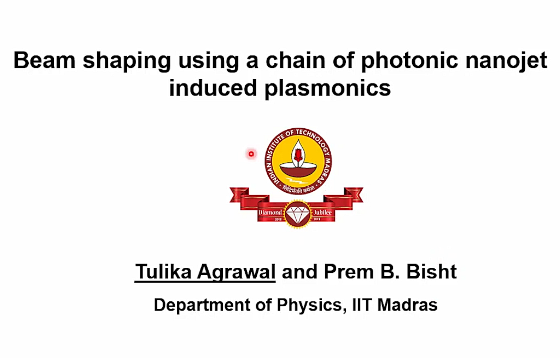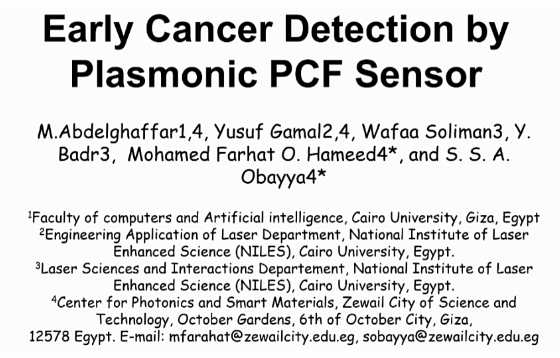Poster61 Videos



GaN avalanche photodiode (APD) has important application prospects in the field of solar-blind ultraviolet (UV) detections. The back-illuminated GaN-based detector has been widely studied due to the advantages such as easy integration with readout circuit. Numerical model of GaN APD is established. The influence of the key function layer (charge layer) thickness on the device […]
D06 – Examination of Resonant Cavity Enhanced Strain Compensated SiGeSn/GeSn Interband MQWIP
In this work, mathematical investigation is done for the potential of Group IV alloy based resonant cavity enhanced interband multiple quantum well photodetector (MQWIP). Strain balanced multiple quantum well structure is proposed to be configured between two Bragg reflectors (mirrors) to form a resonant cavity. Responsivity is calculated by solving the rate equation in each […]
D07 – Theoretical study of back-to-back avalanche photodiodes for mid- and longwave infrared applications
The dual-band N+-p-p-p-P+-p-p-p-n+ avalanche photodiode (APDs) structure is designed and numerically analyzed in detail. We conducted a theoretical study of APD for medium wave (MWIR) and longwave infrared (LWIR) applications. The current-voltage (I-V) characteristics for the bias range -6V
D08 – Numerical Simulation on the Effect of Operation Temperature on the Optical Transfer Characteristics for GaN/AlGaN SAM Avalanche Photodiodes
GaN/AlGaN avalanche photodiodes (APDs) have important application values and broad application potentials in the field of solar-blind ultraviolet (UV) detection. However, the self-heating effect has an obvious influence on the output characteristics of GaN/AlGaN APDs. In order to study the influence of self-heating temperature on its performance, the numerical model of GaN/AlGaN APDs is established […]
D09 – Analysis of Differential Phase Shift Quantum Key Distribution using single-photon detectors
We investigated the performance of differential phase shift quantum key distribution using InGaAs/InP and Silicon-APD (avalanche photo diode) for generating secure keys, secure communication distance, and bit error rates under the various operating conditions.We compare the quantum bit error rate and the secure key generation rate as a function of communication length.Our simulation results show […]
IS06 – Characteristics of All-Optical Gate Switch Employing Quasi-Phase-Matched Lithium Niobate Devices
We analyze characteristics of all-optical switches using the cascade of second harmonic generation and difference frequency mixing in quasi-phase-matched lithium niobate devices. Numerical calculations consider not only the pulse waveforms but also the optical noises.
IS09 – Collision Dynamics of Solitons in a Grating Assisted Semilinear dual-core System with Phase Mismatch
The collision dynamics between two counterpropagating moving Bragg grating solitons and their outcomes in a model of semilinear dual-core Bragg-grating coupler with phase mismatch are investigated. The influence of gratings phase mismatch on the collision outcomes is also discussed.
IS10 – Modelling and Characterisation of Silicon Waveguides in Photonic Integrated Circuits
Modelling and characterization of basic waveguiding structures in integrated photonics is important due to the large variety of established and emerging technologies used for fabrication. In this contribution we present a modelling and characterization approach for integrated silicon waveguides. We provide waveguide characteristics calculated from eigenmode simulation and optical measurement results.
IS11 – Numerical Investigation of the Performance of OAM-Mode Shifting Recirculating Delay Loop Under the Effect of Mode Shifter Displacement
We investigate the effect of OAM mode shifter displacement on the performance of the OAM-mode shifting recirculating delay loop by simulating the beam propagation using Kirchhoff-Fresnel diffraction. Simulation results indicate that 20 delayed replicas may be obtained with >10 dB signal-to-crosstalk ratio (SCR) if alignment is perfect and ℓshift=+1
IS12 – A compact Kerr effect based Plasmonic Logic Device for Nanotechnology Applications
This work utilizes the vital property of Kerr effect of altering the phase of optical signal to numerically investigate the plasmonic XOR/XNOR logic device for nanotechnology applications. Extinction ratio (ER) and insertion loss (IL) of basic switching element (Mach-Zehnder interferometer) is evaluated and plotted as a function of length of interferometric arms. The obtained result […]
IS13 – Design and Performance Analysis of All Optical Half Adder based on Carrier Reservoir SOA -Mach Zehnder Interferometer (MZI) Configuration
In this manuscript, Carrier reservoir SOA (CR-SOA) based half adder is proposed and simulated at 100 Gb/s. CR-SOA has fast carrier recovery, due to presence carrier reservoir which enables its use at higher data rates on the other hand conventional SOA suffers from slow carrier recovery which leads to unequal amplification of pulses. The obtained […]
IS14 – Tunable optical mode converter based on SOI asymmetric channel waveguides
An optical mode converter based on asymmetric dual channel waveguides is reported and analyzed. The first channel is infiltrated with nematic liquid crystal (NLC) material while the second one has BK7 glass core. The first higher order mode of the NLC core is coupled to the fundamental mode of the neighboring core with high coupling […]
IS15 – Inverse Hyperbolic-Tangent Pre-distortion for OOFDM Systems
We propose an inverse hyperbolic-tangent-based digital pre-distorter that can suppress the Mach-Zehnder modulator-induced harmonic distortions by about 13 dB for single-tone signals, while maintaining the peak-to-average power ratio in optical orthogonal frequency division multiplexed signals.
LD11 – Single Transverse Mode Operation of Over 10 µm Wide Ridge-Type Semiconductor Lasers with Transversal Diffraction Gratings Tatsuhiro Hirose and Takahiro Numai
This paper reports on single transverse mode operation of a ridge-type semiconductor laser with transversal diffraction gratings for a mesa width over 10 µm when the number of periods is 160, the grating pitch is 428.7 nm, and the grating depth is 250 nm.
LD12 – Study of reflectivity and resistance properties of p-type distributed Bragg reflectors with composition graded interfaces
In this work, the reflectivity and series resistance of the p-type distributed Bragg reflectors (DBRs) in vertical cavity surface emitting lasers (VCSELs) under the different thickness of composition graded interface layers, Al composition of the high Al composition layers, Al composition of the low Al composition layers, and the number of DBR periods are simulated […]
LD13 – Numerical Analysis of Electrically Pumped SiGeSn/GeSn Quantum Well Transistor Laser
The threshold current density of electrically pumped Sn incorporated group IV alloy based transistor laser (TL) is analyzed by proposing and designing a theoretical model for the same. Active region for the lasing action is formed by strain compensated GeSn single quantum well (QW) in the base of the transistor. The threshold current density for […]
LD15 – Design Analysis of Linear Graded Quantum barriers in Ultravoilet-C Laser Diodes
We demonstrated ultraviolet laser diode with improved optical and electrical features. By employing linear graded rising aluminium concentration in phases from first quantum barrier to last quantum barrier, the suggested LD design improves internal quantum efficiency (IQE) and output power while minimizing the lasing threshold. The proposed LD increases optical gain while lowering carrier leakage […]
LED03 – RGB LED active region design and optimization with Genetic Evolution Algorithm
Multi-quantum-well (MQW) LED is a complex distributed system with strong interaction between two opposite carrier flows, electrons and holes. For both types of carriers, the carrier injection into each QW depends on transport conditions across the whole active region (AR) and is affected by capture-recombination balance in all active QWs. Multi-color LEDs with different types […]
LED06 – Ray Tracing Simulation of a GaN-based integrated LED-Photodetector System
An optical sensor system consisting of a pair of GaN LED and Photodetector (PD) is simulated using COMSOL Multiphysics, and the possibility of using this system as absorption coefficient sensor is studied. By locating both LED and PD on a same substrate and measuring transmitted power to the PD, it would be possible to sense […]
LED07 – Effect of Parabolic Quantum Well on Internal Quantum Efficiency of InGaN/GaN based MicroLED at low current density
The quantum cascade stark effect (QCSE) in rectangular shaped quantum well (QW) poses a hindrance to increase the internal quantum efficiency (IQE) of nitride based LEDs. To circumvent the said problem for micro-LEDs operating at low current density, a parabolic QW structure has been proposed which is found to be useful to alleviate the QCSE […]
LED08 – Influence of Prestrained Graded InGaN interlayer on the Optical Characteristics of InGaN/GaN MQW-based LEDs
In this work, an InGaN/GaN multi-quantum well light emitting diode is designed with different kinds of prestrain layers (InGaN) inserted between the active region and n-GaN layer to demonstrate the effects of piezoelectric polarization on GaN-based LEDs. The device describes a GaN buffer layer which promotes charge injection by minimizing energy barrier between electrode and […]
LED09 – Enhanced optoelectronic properties of UV-C light-emitting diode
We numerically analyzed proposed structure named as LED S2 in comparison to reference structure LED S1. In LED S2 we introduced undoped AlGaN and p-AlGaN layers between the electron blocking layer (EBL) and the p-GaN (hole injecting layer). The simulation finding shows proposed structure (LED S2) provide a better strategy for lowering electron overflow and […]
MM11 – The Variations of Photoluminscence Decay Times Under The Influence of A Trapping State
We numerically calculated the time-resolved photoluminescence spectra using the bimolecular trapping-detrapping model. The variations of carrier lifetimes are investigated by changing the carrier recombination and trapping rate constants, as well as the concentration of available trapping states.
N03 – Band structures in highly strained 3D nanowires
We mathematically derive a new nonlinear strain model to simulate the conduction and valence bands in highly bent 3D hexagonal nanowires with GaAs core and asymmetric (AlαIn1-α)As stressor. The model is based on a transformation of the 1st Piola-Kirchhoff stress tensor and an appropriate energy functional that captures the dynamics of the induced strain due […]
N05 – Effect of Poole-Frenkel emission on electroluminescence in quantum dot light emitting devices with Nickel Oxide layer
Theoretical analysis of hybrid quantum dot-light emitting devices incorporating CdSe/ZnS core/shell quantum dots and Nickel Oxide (NiO) as hole injection layer (HIL) has been carried out in this work. The replacement of organic HIL such as poly(3,4-ethylenedioxythiophene):poly(styrenesulfonate) (PEDOT:PSS) with solution-processed NiO layer has led to enhancement of current density and luminance in the device by […]
N06 – Numerical simulations of nonparaxial solitons and their interaction dynamics in coupled Helmholtz systems
The role of nonparaxiality provides a fertile ground for fabricating miniaturized nanoscale devices. In this work, we examine the existence of nonparaxial solitons in a dimensionless coupled nonlinear Helmholtz system, allowing the propagation of ultra-broad nonparaxial pulses in a birefringent optical waveguide. We analytically obtain a bright soltion solution by using standard Hirota’s bilinearization method. […]
N07 – DFT investigation of optoelectronic properties of ultra-small C, CN and SiC nanotubes
We investigated the optoelectronic properties of ultra-small armchair (3,3) carbon (C), carbon nitride (CN) and silicon cabride (SiC) nanotubes using the density functional theory (DFT). We performed the calculations for two potentials Perdew-Burke-Ernzerhof Generalized Gradient Approximation (PBEGGA) and Tran-Blaha modified Becke-Johnson (TB-mBJ) potential. The results show a semiconducting nature with direct and indirect gap for […]
N08 – Inverse Design of Multilayer Thin film by Deep Neural Network
Inverse Design of TiO2 − SiO2 based multilayer thin film for normal incidence of TM polarized light in visible region by Deep Neural Network is reported. The simulated and the target transmission spectra are closely following.
N09 – Beam shaping using a chain of photonic nanojet induced plasmonics
Photonic nanojet arises from a microcavity leading to high electric field. On the other hand, metal nanoparticles (NPs) lead to high field due to localization in small volumes. In this work, PNJ from an array of cavity induced plasmon resonances has been studied. The sharp profile of the PNJ has been observed by the inclusion […]
NM07 – Early Cancer Detection by Plasmonic PCF Sensor
Great research work has been studied for cancer detection due to its high death rate. In this paper, a novel design of photonic crystal fiber (PCF) biosensor based on surface plasmon resonance (SPR) is introduced and numerically analyzed for cancer cell detection. Full vectorial finite element method (FVFEM) is used throughout the numerical analysis of […]



